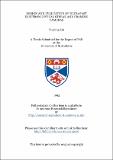Files in this item
Design and evaluation of ultrafast electron-optical streak and framing cameras
Item metadata
| dc.contributor.advisor | Sibbett, Wilson | |
| dc.contributor.author | Liu, Yueping | |
| dc.coverage.spatial | 211 p. | en_US |
| dc.date.accessioned | 2018-07-06T09:15:58Z | |
| dc.date.available | 2018-07-06T09:15:58Z | |
| dc.date.issued | 1993-07 | |
| dc.identifier.uri | https://hdl.handle.net/10023/15036 | |
| dc.description.abstract | The assessment of the performance of ultrafast electron-optical cameras operating in single-shot, synchroscan streak modes and framing mode has been accomplished and it has provided a better understanding of the limiting factors in the performance of these systems. The characterisation of a Photochron IV streak camera in synchroscan operation has been carried out and this has indicated that apart from the limiting time resolution of the streak tube itself, the amplitude and phase noise in laser sources and electronic circuitry also represent significant limitations to the overall system performance. The simulation of space-charge effects in the single-shot operation of streak cameras has demonstrated that space-charge effects are the key factor that limits the dynamic range. The use of travelling-wave deflection systems has been shown to offer a high deflection sensitivity over a broad frequency range. To achieve femtosecond time resolutions from both synchroscan and single-shot streak cameras, the design of a Photochron V streak tube having optimised electron-optical focusing and deflection systems has been discussed. Analyses have indicated that a limiting time resolution of 250 fs is to be expected. Preliminary tests on an experimental version of a Photochron V tube operating in a synchroscan mode have shown a recorded pulse duration of 3.8 ps. Quantitative theoretical studies of output temporal responses of this tube for different input temporal profiles have indicated that it can reproduce temporal structures of input signals with high fidelity for both synchroscan and single-shot operations in a timescale of around Ips. The analysis of the Picoframe type of framing cameras has led to the refinements of the dynamic performance. For the future development, proposals have been made for the designs of a new streak tube having high dynamic range and a new framing tube having frame times less than 10 ps with potential applications in medical diagnosis. | en_US |
| dc.language.iso | en | en_US |
| dc.publisher | University of St Andrews | |
| dc.subject.lcc | TK8360.C2L5 | |
| dc.title | Design and evaluation of ultrafast electron-optical streak and framing cameras | en_US |
| dc.type | Thesis | en_US |
| dc.contributor.sponsor | Oversea Research Scholarship | en_US |
| dc.type.qualificationlevel | Doctoral | en_US |
| dc.type.qualificationname | PhD Doctor of Philosophy | en_US |
| dc.publisher.institution | The University of St Andrews | en_US |
This item appears in the following Collection(s)
Items in the St Andrews Research Repository are protected by copyright, with all rights reserved, unless otherwise indicated.

